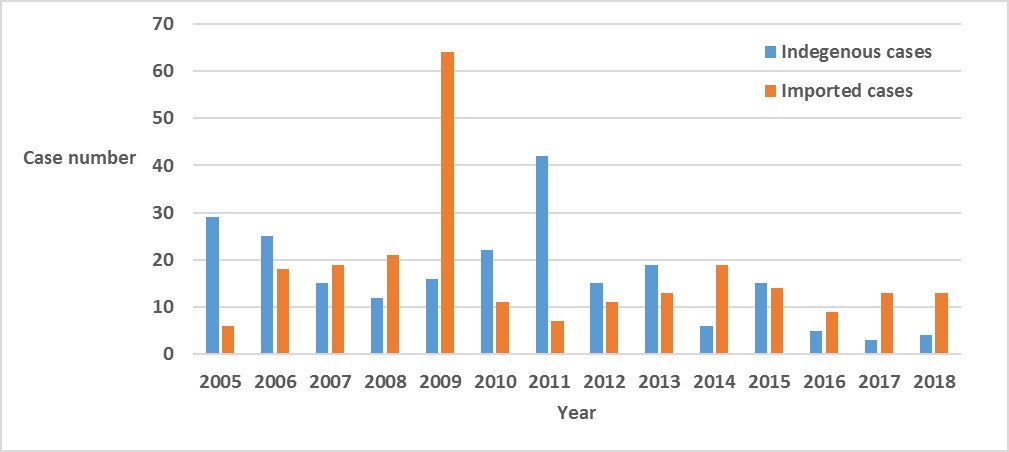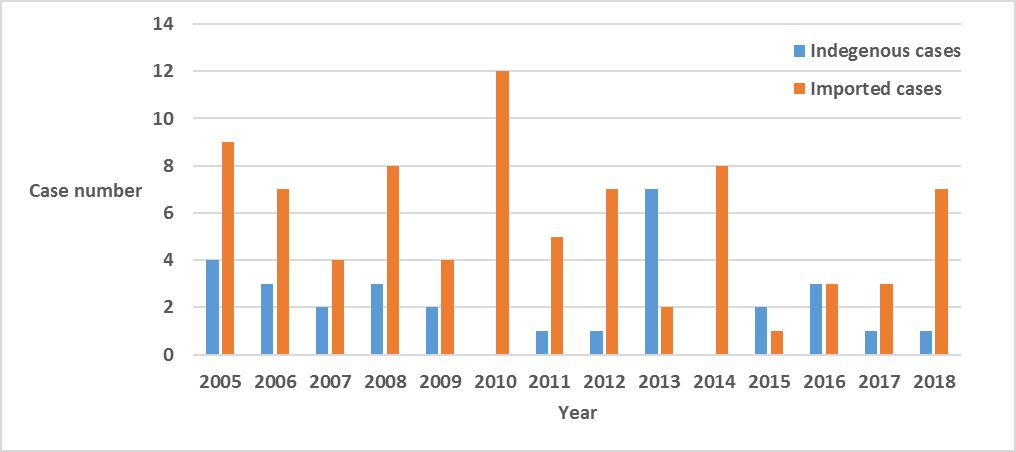Typhoid Fever and Paratyphoid Fever
Background
Typhoid and paratyphoid fevers are caused by the bacteria Salmonella typhi and Salmonella paratyphi respectively. Typhoid fever is a bacterial infection of the intestinal tract and bloodstream. Symptoms can be mild or severe and include sustained fever as high as 39°-40° C, malaise, anorexia, headache, constipation or diarrhoea, rose-coloured spots on the chest area and enlarged spleen and liver. Most people show symptoms 1-2 weeks after exposure. Paratyphoid fever has similar symptoms to typhoid fever but is generally a milder disease.
Typhoid and paratyphoid germs are passed in the faeces and urine of infected people. People become infected after eating food or drinking beverages that have been handled by a person who is infected or by drinking water that has been contaminated by sewage containing the bacteria. Once the bacteria enter the person’s body they multiply and spread from the intestines, into the bloodstream.
Even after recovery from typhoid or paratyphoid, a small number of individuals (called carriers) continue to carry the bacteria. These people can be a source of infection for others. The transmission of typhoid and paratyphoid in less-industrialized countries may be due to contaminated food or water. In some countries, shellfish taken from sewage-contaminated beds is an important route of infection. Where water quality is high, and chlorinated water piped into the house is widely available, transmission is more likely to occur via food contaminated by carriers handling food.
Epidemiology
Typhoid and paratyphoid fevers are common in less-industrialized countries, principally owing to the problem of unsafe drinking-water, inadequate sewage disposal and flooding. An estimated 22 million cases of typhoid fever and 200,000 related deaths occur worldwide each year; an additional 5 million cases of paratyphoid fever are estimated to occur annually.
Each year in the United States, approximately 300 cases of typhoid fever and 100 cases of paratyphoid fever are reported, most in recent travelers. The risk of typhoid fever is highest for travelers to southern Asia (6–30 times higher than for all other destinations). Other areas of risk include East and Southeast Asia, Africa, the Caribbean, and Central and South America.
At present, most of typhoid and paratyphoid confirmed cases belong to imported cases in Taiwan, especially foreign workers and those returning to Southeast Asia, but there are still sporadic cases occur annually domestic.

Figure1: Typhoid Fever Confirmed Cases in Taiwan, 2002-2018

Figure2: Paratyphoid Fever Confirmed Cases in Taiwan, 2002-2018, 2002-2016
Surveillance in Taiwan
- Taiwan National Infectious Disease Statistics System─Typhoid Fever
- Taiwan National Infectious Disease Statistics System─Paratyphoid Fever
Prevention and Control
- Avoid risky foods and drinks.
- (1)If you drink water, buy it bottled or bring it to a rolling boil for 1 minute before you drink it. Bottled carbonated water is safer than uncarbonated water.
- (2) Ask for drinks without ice unless the ice is made from bottled or boiled water. Avoid popsicles and flavored ices that may have been made with contaminated water.
- (3)Eat foods that have been thoroughly cooked and that are still hot and steaming.
- (4)Avoid raw vegetables and fruits that cannot be peeled. Vegetables like lettuce are easily contaminated and are very hard to wash well.
- (5)When you eat raw fruit or vegetables that can be peeled, peel them yourself. (Wash your hands with soap first.) Do not eat the peelings.
- (6)Avoid foods and beverages from street vendors. It is difficult for food to be kept clean on the street, and many travelers get sick from food bought from street vendors.
- Get vaccinated against typhoid fever.
- If you are traveling to a country where typhoid is common, you should consider being vaccinated against typhoid. But, the vaccine does not provide complete protection from infection.
FAQs
1. How does a person get Typhoid Fever and Paratyphoid Fever?
You can get typhoid fever if you eat food or drink beverages that have been handled by a person who is shedding Salmonella Typhi or if sewage contaminated with Salmonella Typhi bacteria gets into the water you use for drinking or washing food.
2. What are the symptoms of Typhoid Fever and Paratyphoid Fever?
(1)Symptoms can be mild or severe and include sustained fever as high as 39°-40°C, malaise, anorexia, headache, constipation or diarrhoea, rose-coloured spots on the chest area and enlarged spleen and liver.
(2)Most people show symptoms 1-2 weeks after exposure. Paratyphoid fever has similar symptoms to typhoid fever but is generally a milder disease.
3.How is Typhoid Fever and Paratyphoid Fever spread?
(1)Typhoid and paratyphoid germs are passed in the faeces and urine of infected people. People become infected after eating food or drinking beverages that have been handled by a person who is infected or by drinking water that has been contaminated by sewage containing the bacteria.
(2) Once the bacteria enter the person’s body they multiply and spread from the intestines, into the bloodstream. The body reacts with fever and other signs and symptoms.
More Information
- WHO|Typhoid Fever
- USA CDC|Typhoid Fever
Images


